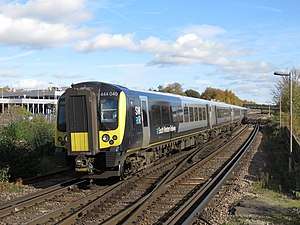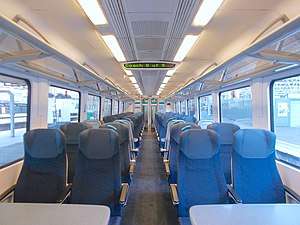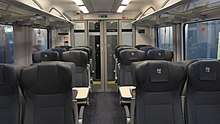British Rail Class 444
The British Rail Class 444 is an electric multiple-unit passenger train built by Siemens in Austria between 2002 and 2004. They currently operate on express passenger services for South Western Railway.
| British Rail Class 444 Desiro | |
|---|---|
 South Western Railway Class 444 No. 444040 at Basingstoke | |
 The interior of refurbished Standard Class aboard a South Western Railway Class 444 | |
| In service | 21 April 2004 – Current |
| Manufacturer | Siemens Mobility |
| Built at | Vienna, Austria |
| Family name | Desiro |
| Replaced | Class 442 Class 423 Class 421 Class 411 Class 412 |
| Number built | 45 trainsets |
| Formation | 5 cars per trainset |
| Capacity | 299 standard, 35 first |
| Operator(s) | South Western Railway |
| Specifications | |
| Car length | 23 m (75 ft 5 1⁄2 in)[1] |
| Maximum speed | 100 mph (161 km/h)[1] |
| Weight | Total: 227 tonnes (223 long tons; 250 short tons)[1] |
| Traction motors | (?) |
| Power output | 2,000 kW (2,680 hp) |
| Electric system(s) | 750 V DC third rail |
| Current collection method | contact shoe |
| Braking system(s) | Air, regenerative |
| Track gauge | 1,435 mm (4 ft 8 1⁄2 in) standard gauge |
Part of the Siemens Desiro family, the class first entered service with South West Trains in 2004.
Description
At the start of the 21st century, as part of its franchise agreement, South West Trains was required to replace the slam-door rolling stock of Classes 411, 412, 421 and 423, which did not meet modern health and safety standards, with new trains by 2005.[2] In April 2001 an order was placed with Siemens for 785 vehicles. This was originally to be split as 100 four-car Class 450/0 outer-suburban units, 32 five-car Class 450/2 inner-suburban units, and 45 five-car Class 444 express units.
The Class 444 fleet was built at Siemens' Vienna plant.[2] Before being shipped to Britain via the Channel Tunnel, the trains were extensively tested on the test-track at Wildenrath.[2] This was an attempt to reduce the time taken for new trains to enter service, by ironing out any problems beforehand. Many other designs of new train, such as the Alstom Class 458 units, had been plagued by problems and poor reliability. The Desiro fleet entered service faster than its competitors, but still suffered teething problems.
The trains are formed of five cars, and are numbered in the range 444001-045. Each unit is formed of two outer driving motors, two intermediate trailers, and an intermediate buffet car. The description of this formation is DMSO+TSO+TSO+TSRMB+DMCO. Individual vehicles are numbered as follows.
- 63851-63895 – DMCO
- 67201-67245 – TSRMB – fitted with Pantograph Well
- 67151-67195 – TSO
- 67101-67145 – TSO
- 63801-63845 – DMSO
The units have end-gangways, allowing passengers to move between units when used in multiple. Trains are limited to a 10-car length (i.e. two units), as longer trains cannot be accommodated in stations. At some stations with particularly short platforms (for example Shawford, in Hampshire), even a single unit of five cars is too long for the platform. Passengers used to have to board and alight via a single door opened by the guard, however, since the introduction of automatic selective door operation (ASDO) in early 2015, the computer system works out how many cars to release the doors on. The fleet is painted in a mixture of SWT's express livery of white, with a blue window band, and red/orange swishes at the cab ends (although they now have the South West Trains logo covered with a South Western Railway one) and the new South Western Railway livery being applied gradually across the entire SWR fleet.
Each five-car unit has a first-class section taking up just over half of one car at one end. All seats have BS 1363 sockets providing AC power for laptops or mobile phone chargers.
Like all new-build third-rail rolling stock in the UK, one car in each unit is fitted with a recess for a pantograph. This allows for a future conversion to AC overhead power, although at present no trains in this fleet have been so fitted.
All sets are based at the purpose-built Siemens Northam Carriage Servicing Depot at Southampton.
A new variable-stiffness hydraulic bush has been fitted to the whole Class 444 fleet so as to reduce track damage and thus infrastructure maintenance costs. This work was completed by the end of 2013.[3]
Awards
Class 444 trains have been awarded the "Golden Spanner 2010" as Britain's most reliable trains by Modern Railways. During twelve months, SWT's fleet has set a new reliability record of almost 89,000 kilometres per technical delay.[4]
Operations
The first Class 444 units entered service with SWT in early 2004. As part of the launch, unit no. 444018 was named "The Fab 444" at a ceremony at London Waterloo.
The units were introduced on services from London Waterloo to Portsmouth Harbour via the Portsmouth Direct Line. They were also used on some services on the South Western Main Line to Southampton Central, Bournemouth, Weymouth and on limited outer suburban services to Alton and Basingstoke. This allowed the withdrawal of the final 411 units by mid-2004, and inroads were made to the 421 and 423 fleets.
It was originally hoped that the final slam-door trains would be withdrawn by the end of 2004. In the event, some were allowed to remain operational until May 2005, as the last replacement Desiros came into service. Initially, the Class 444s were used mainly on Portsmouth direct services, allowing the Class 442 units to be used on the Weymouth line. The Class 444 units were also used regularly on Sunday-only Bournemouth stopping services, Waterloo to Southampton services and the Brockenhurst to Wareham shuttle service. Previous power limitations meant that the trains were not permitted to run west of Poole; these restrictions have since been lifted.
During 2007, the Class 444 units replaced the Class 442s on the Weymouth line. Some Class 442 workings were taken over by Class 444s as early as November 2006; the final Class 442 was withdrawn in February 2007. Class 444s transferred to the Weymouth line were replaced on Portsmouth services by Class 450 Desiros which became available after the reintroduction of the Class 458 units on the Waterloo to Reading line. The decision to transfer many 444s units to the Weymouth line was not popular. Portsmouth line passengers protested over the use of class 450s on some services,[5] while there were complaints that the 444s were inferior to the units they replaced on the Weymouth line.[6]

Class 444s are currently used on the following services:
- Waterloo to Basingstoke (peak services)
- Waterloo to Poole (shared with Class 450 and British Rail Class 442)
- Waterloo to Portsmouth Harbour via Guildford (shared with Class 450 and British Rail Class 442)
- Waterloo to Portsmouth Harbour via Basingstoke and Fareham (shared with Class 450)
- Waterloo to Weymouth via Winchester and Southampton Central
SWR Refurbishment

South Western Railway have been conducting a refurbishment programme as part of their contract from 2017 onwards. As part of this work, every unit will be deep cleaned, with carpets and seat covers in Standard Class replaced. In addition, plug sockets will be provided at every pair of seats, and the buffet unit will be removed to provide extra seats. First Class will be reduced from 35 seats to 32 with the 2+1 seating to be replaced by 2+2 seating, with leather seats and new tables providing facilities for wireless charging.[7]
Fleet details
| Class | Operator | No. Built | Year Built | Cars per Set | Unit nos. |
|---|---|---|---|---|---|
| Class 444 | South Western Railway | 45 | 2002–2004 | 5 | 444001 – 444045 |
References
- Desiro UK Class 444 Multiple Unit Archived 6 October 2011 at the Wayback Machine – Siemens Mobility. Page 38. Retrieved 19 July 2011.
- Class 444 – Southern E-Group. Retrieved 19 July 2011.
- "Desiro bushes giving a smoother ride". Rail. Peterborough. 10 August 2011. p. 9.
- "Siemens Desiro Class 444 wins award as most reliable train". Transport Weekly. 12 January 2011. Retrieved 15 January 2011.
- "Commuter protest over rail seats". BBC News. 22 January 2007. Retrieved 10 May 2008.
- Jolliffe, Bob (21 January 2007). "Councillor sceptical at train service changes". Bournemouth Daily Echo. Retrieved 11 March 2012.
- "SWR Refurbishment". Retrieved 29 November 2018.
| Wikimedia Commons has media related to British Rail Class 444. |